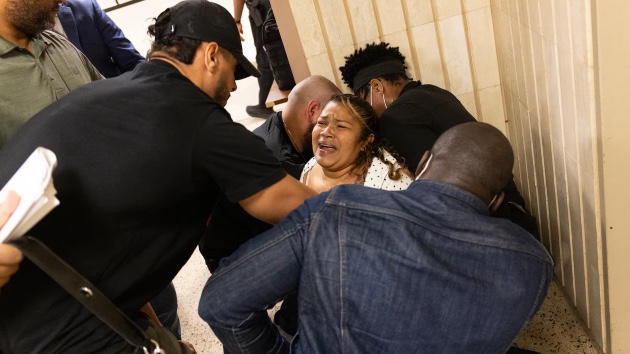
(NEW YORK) — President Donald Trump campaigned for president on the promise of mass deportations that targeted criminals — and while ICE agents have arrested over 38,000 migrants with criminal convictions, new data shows a recent shift toward also arresting those who have not been accused of crimes.
In recent weeks, the Trump administration has arrested an increasing number of migrants with no criminal convictions, according to an ABC News analysis of Immigration and Customs Enforcement data.
The numbers, which were obtained through a public records lawsuit and released by the Deportation Data Project at the University of California Berkeley, give the first real glimpse of how Trump’s immigration enforcement policy is playing out in the streets.Over the first five months of the Trump administration, ICE has arrested over 95,000 individuals, according to data analyzed by ABC’s owned television stations’ data team.
At the start of the administration, ICE tended to target migrants with pending or criminal convictions. From Inauguration Day to May 4, 2025, 44% of those arrested had a criminal conviction, while 34% of those arrested had pending charges and 23% had no criminal history, according to the data.
But beginning May 25, the data appears to show there was a shift in enforcement — with individuals with criminal convictions making up only 30% of those arrested. Those arrested with pending criminal charges accounted for 26% of the individuals arrested and 44% had no criminal history.
“It looks like there’s been a shift from about Memorial Day this year up until now, to an increasing number of people who have been detained who have no criminal charges,” said Austin Kocher, a professor at Syracuse University who reviewed the data.
“We hear a lot about the administration deporting the worst of the worst. And as far as we can tell from all available data up to this point, the data has not really supported that,” Kocher said.
The data is largely divided into three groups of individuals: those who have criminal convictions, those with pending charges, and those who may be facing civil immigration charges, labeled as “other immigration violators.” However, the data provides no indication of what kind of crimes the individuals may be accused or convicted of.
In Los Angeles, where ICE raids recently sparked large demonstrations, and in the New York City area, almost 60% of those arrested by ICE in the first ten days of June had no criminal convictions nor any pending criminal charges, according to the data.
Asked about the shift, Department of Homeland Security Assistant Secretary Tricia McLaughlin told ABC News, “We are not going to disclose law enforcement sensitive intelligence and methods. 70% of the arrests ICE made were of criminal illegal aliens.”
“We are continuing to go after the worst of the worst — including gang members, pedophiles, and rapists,” McLaughlin said. “Under Secretary [Kristi] Noem, we are delivering on President Trump’s and the American people’s mandate to arrest and deport criminal illegal aliens and make America safe.”
The majority of administration’s migrant arrests have taken place in Texas, the state with the longest southern border. But the data also shows that enforcement has largely shifted away from apprehensions at the southern border to apprehensions in the interior of the country.
John Sandweg, the former acting director of ICE under President Barack Obama, told ABC News that the shift in enforcement is not a surprise, considering that illegal border crossings are down dramatically.
“For the last probably 15 years at least, the majority of ICE arrests, people booked into ICE custody or ICE apprehensions, were individuals apprehended at the border. But now, the administration is very sensitive to the numbers and has started putting ICE under pressure,” Sandweg said, referring to Trump’s call for more migrants to be deported.
“The problem is that you are now engaged in operations that are, frankly, more likely to find non-criminals than criminals,” Sandweg said.
As ABC News previously reported, ICE’s latest tactic has been arresting individuals at immigration courts. In most cases, when a deportation case is dismissed, it is a positive outcome for a migrant, attorneys told ABC News — but according to immigration attorneys and advocates, immigration enforcement officers have been waiting in immigration court buildings and coordinating with DHS lawyers to arrest migrants promptly after their cases are dismissed, after which the migrants are placed into expedited removal proceedings without allowing them to fight their case.
“If there’s anything that says this isn’t about serious criminal enforcement, it’s this wholesale dismissal of cases of the people who are showing up in immigration court,” Sandweg said. “I mean, you want to find the place where you’re least likely to find dangerous criminals — it’s the people who show up for their immigration court hearings.”
Sandweg said these new types of enforcement, including courthouse arrests, are being made in an effort to achieve quotas set by the Trump administration.
“It’s another way to just quickly make some arrests,” Sandweg said.
The administration, meanwhile, says it’s continuing its efforts to target accused criminals.
At a press conference on Friday, Attorney General Pam Bondi said federal authorities have arrested 2,711 alleged multinational gang members since Trump re-took office in January.
“You should all feel safer that President Trump can deport all of these gangs and not one district court judge can think they’re emperor over this Trump administration and his executive powers,” she said.
Copyright © 2025, ABC Audio. All rights reserved.
